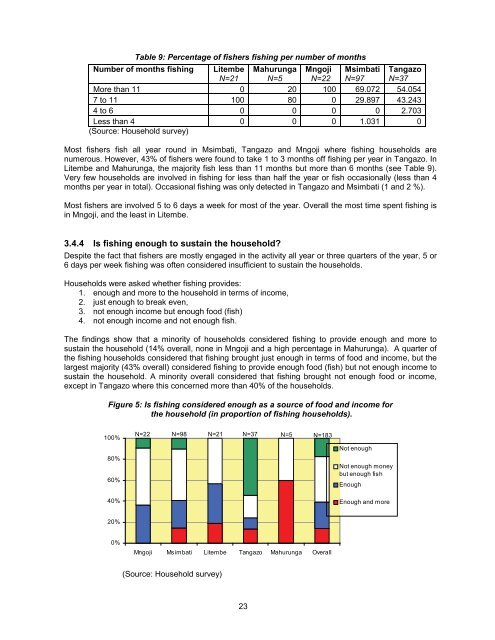a socio-economic baseline assessment of the mnazi bay - IUCN
a socio-economic baseline assessment of the mnazi bay - IUCN
a socio-economic baseline assessment of the mnazi bay - IUCN
You also want an ePaper? Increase the reach of your titles
YUMPU automatically turns print PDFs into web optimized ePapers that Google loves.
Table 9: Percentage <strong>of</strong> fishers fishing per number <strong>of</strong> months<br />
Number <strong>of</strong> months fishing Litembe<br />
N=21<br />
Mahurunga<br />
N=5<br />
Mngoji<br />
N=22<br />
Msimbati<br />
N=97<br />
Tangazo<br />
N=37<br />
More than 11 0 20 100 69.072 54.054<br />
7 to 11 100 80 0 29.897 43.243<br />
4 to 6 0 0 0 0 2.703<br />
Less than 4 0 0 0 1.031 0<br />
(Source: Household survey)<br />
Most fishers fish all year round in Msimbati, Tangazo and Mngoji where fishing households are<br />
numerous. However, 43% <strong>of</strong> fishers were found to take 1 to 3 months <strong>of</strong>f fishing per year in Tangazo. In<br />
Litembe and Mahurunga, <strong>the</strong> majority fish less than 11 months but more than 6 months (see Table 9).<br />
Very few households are involved in fishing for less than half <strong>the</strong> year or fish occasionally (less than 4<br />
months per year in total). Occasional fishing was only detected in Tangazo and Msimbati (1 and 2 %).<br />
Most fishers are involved 5 to 6 days a week for most <strong>of</strong> <strong>the</strong> year. Overall <strong>the</strong> most time spent fishing is<br />
in Mngoji, and <strong>the</strong> least in Litembe.<br />
3.4.4 Is fishing enough to sustain <strong>the</strong> household?<br />
Despite <strong>the</strong> fact that fishers are mostly engaged in <strong>the</strong> activity all year or three quarters <strong>of</strong> <strong>the</strong> year, 5 or<br />
6 days per week fishing was <strong>of</strong>ten considered insufficient to sustain <strong>the</strong> households.<br />
Households were asked whe<strong>the</strong>r fishing provides:<br />
1. enough and more to <strong>the</strong> household in terms <strong>of</strong> income,<br />
2. just enough to break even,<br />
3. not enough income but enough food (fish)<br />
4. not enough income and not enough fish.<br />
The findings show that a minority <strong>of</strong> households considered fishing to provide enough and more to<br />
sustain <strong>the</strong> household (14% overall, none in Mngoji and a high percentage in Mahurunga). A quarter <strong>of</strong><br />
<strong>the</strong> fishing households considered that fishing brought just enough in terms <strong>of</strong> food and income, but <strong>the</strong><br />
largest majority (43% overall) considered fishing to provide enough food (fish) but not enough income to<br />
sustain <strong>the</strong> household. A minority overall considered that fishing brought not enough food or income,<br />
except in Tangazo where this concerned more than 40% <strong>of</strong> <strong>the</strong> households.<br />
Figure 5: Is fishing considered enough as a source <strong>of</strong> food and income for<br />
<strong>the</strong> household (in proportion <strong>of</strong> fishing households).<br />
100%<br />
80%<br />
60%<br />
40%<br />
N=22 N=98 N=21 N=37 N=5 N=183<br />
Not enough<br />
Not enough money<br />
but enough fish<br />
Enough<br />
Enough and more<br />
20%<br />
0%<br />
Mngoji Msimbati Litembe Tangazo Mahurunga Overall<br />
(Source: Household survey)<br />
23
















